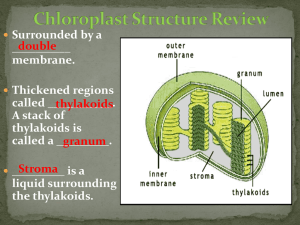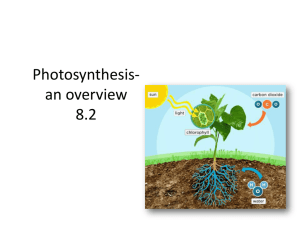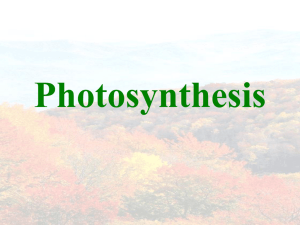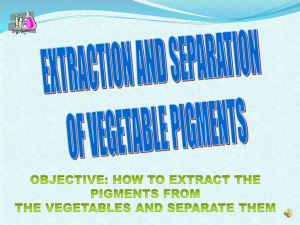photosynthesis part 1
advertisement
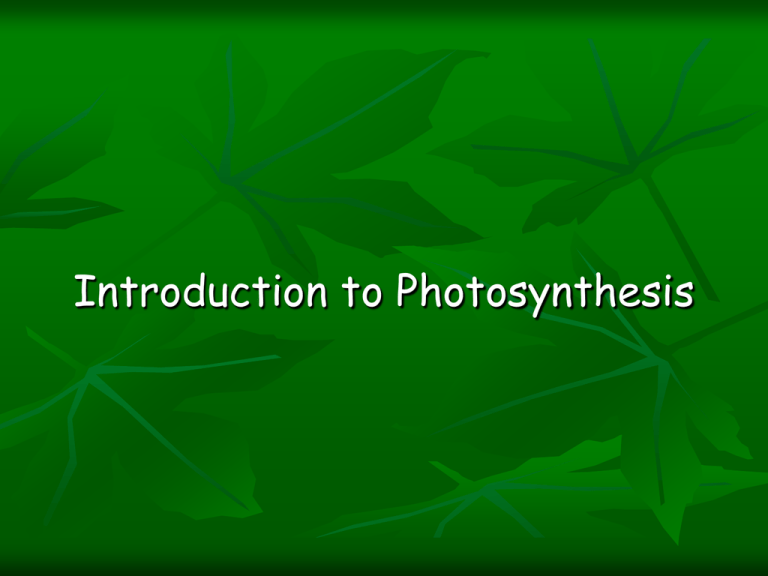
Introduction to Photosynthesis Heterotrophs Heterotrophs: Organisms that can not make their own food Obtain food by eating other living things 2 Autotrophs Autotrophs: Organisms that can make their own food Photosynthesis Process by which plants use energy from sunlight to produce their food Carbon dioxide + water 6CO2 + 6H2O sunlight sunlight Glucose + oxygen C6H12O6 + 6O2 Location of Photosynthesis Photosynthesis occurs in the chloroplasts Absorbs light in photosynthesis Chloroplast Strom Outer Membranea Inner Membrane Thylakoid Has a double membrane (inner and outer membranes) System of flattened sacs called thylakoids Stack of thylakoids granum (plural grana) Stroma: Gel like material around the grana Granum Sunlight Sunlight appears as white light, but it is actually a mixture of different wavelengths. See wavelengths as different colors (red-violet) Pigments Plants gather the sun’s energy with lightabsorbing molecules called pigments. Located in thylakoid membranes Different pigments absorb different wavelengths of light. Chlorophyll is the primary light absorbing pigment. Chlorophyll 2 main types of chlorophyll- chlorophyll a and chlorophyll b Absorbs light in the blue-violet and red regions, but not in the green region. Leaves reflect green light, which is why plants look green. Carotenoids Red, orange, and yellow pigments called carotenoids are also found in the thylakoids. Act as accessory pigments: absorb additional wavelengths of light energy that is transferred to chlorophyll a In the fall, as the amount of chlorophyll declines, accessory pigments become more visible. Interaction Reflection pg.28 Explain why it is beneficial for plants to contain more than 1 type of pigment. Paper Chromatography Chromatography: “color writing” a process that separates a mixture into its individual components The pigments in a leaf can be separated Uses a solvent to carry and separate the pigments Capillary action (movement upward against gravity) allows the solvent and pigments to move up the filter paper The pigments are separated at different rates depending on :1) solubility in the solvent and 2) attraction to the filter paper Solvent Paper Chromatography- Ink Separation Spinach Lab 1. Cut filter paper with a point at the end. Draw faint pencil line. Attach paper clip to cork (ALREADY DONE FOR YOU), and strip of paper to paper clip (see set up diagram). 2. Tear spinach leaves into small pieces. Place in mortar with a little sand, and 5ml of ethyl alcohol (ETHANOL). Grind with pestle. 3. Use glass rod to transfer drops of pigment extract to center of pencil line. Let dry. Repeat about 20 times. 4. Pour 5ml of chromatography solvent into test tube (ALREADY DONE FOR YOU). The tip of filter paper should just touch the surface of the solvent. Once solvent reaches the top, take paper out to dry for about a minute. PLACE CORK BACK INTO TEST TUBE AFTER TAKING OUT FILTER PAPER TO DRY!! 5. Observe bands of pigments. DRAW YOUR RESULTS (BAND OF COLORS) ON THE DIGRAM OF THE SET UP. Measure the distance of each band in centimeters.

